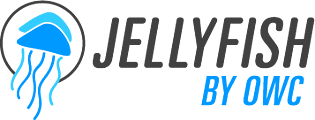Copying Media from Camera Cards, Set Shuttle Drives to OWC Jellyfish Using Kyno
Kyno has a unique feature called Copy and Verify. This allows the user to copy data from a camera card, external hard drive, DIT drives, or any other source to a single or multiple locations. For the purpose of this demo, we will be copying data from an on-set Shuttle Drive to the OWC Jellyfish that has a RAID.
A verified copy of your data enters the post-production pipeline with peace of mind due to industry standard checksums that environment by copying the media with checksums onto the OWC Jellyfish for file accuracy and reporting that gives you accurate information in regards to what was transferred over and what came in with corruption.
Step by Step
To create checksum-verified copies of entire drives, camera media, or folders, open the context menu of a folder or drive in the Navigator or (workspace for convenience) on the right-hand side and choose "Copy and Verify..." or press Cmd-Shift-C (Mac) or Control-Shift-C (Win). You can also select the drive and from the edit, menu, select Copy and Verify.
This will open a dialog with a few options:
Submitting the dialog will start an asynchronous job that you can monitor in the activity view.
If the job fails you can look at the errors by pressing the "i" icon on the job.
Kyno uses the xxHash algorithm to create checksums of the copied files.
Options
Source
The drive or folder that was selected in the Navigator will be chosen by default. Change it by pressing "Select a Source".
Destination(s)
Open the "Select a Destination" dropdown to choose an available drive or folder as the destination.
Kyno Premium only ( included with your OWC Jellyfish): a new line will be added automatically once you've chosen the first one (press "Select 2nd", Select 3rd"... to choose). Kyno Premium supports up to 4 destinations.
Backup Name
Kyno will create a folder on the destination(s) with this name. The Backup Name is also used as a name for the Media Hash List file (MHL, see below) and in the content of the MHL file.
Log Info
The log info is used in the MHL file.
Create Media Hash List (MHL)
When checked Kyno creates a media hash list file, a standard file format containing an inventory of all the copied files and their respective hash values alongside some general information of the copy job. The MHL file can be used to verify the backup at a later point using 3rd party tools, see https://mediahashlist.org/ for details.
Choosing a Verification Method
xxHash64 BE
xxHash64 BE (Big Endian): generally the same as the xxHash algorithm. However, it outputs a hash string in hexadecimal values, which makes it more compatible with some post production workflows. It is potentially faster on very large data transfer rate setups. This hashing algorithm is compatible with Google’s xxhash implementation. Endianness information: https://en.wikipedia.org/wiki/Endianness
MD5
MD5 is widely used. It comes from an encryption background, but it can also be used to detect transfer errors. Limited to 300MB/sec on recent hardware. MD5 is so complex to calculate, that more than 300 MB/sec is not possible on today’s computers. It checks the entire content of each file and its size.
SHA1
SHA1 also comes from an encryption background, but can also be used to detect transfer errors. Limited to 300MB/sec on recent hardware. Checks the entire content of each file and its size.
Source: Learn more about Checksum Verification Methods
Find and replace corrupted files
Kyno normally uses file size and modification date to determine whether a file should be copied. While uncommon, it is possible for a file on the destination to become corrupt, and this would not be noticed until you use the file or manually verify the copy. The "Find and replace corrupted files" option causes Kyno to re-read every file on the source and destination, calculate a checksum, then use that checksum to determine if each file should be copied. We recommend using this option for extra peace of mind when making a full and final incremental backup.
Activating this option will greatly increase incremental backup time.
Ignore hidden files and folders
When checked Kyno will not copy hidden files (or files with a leading dot on macOS). Attempting to offload hidden files, can create offload errors and should most times not be included at all. Therefore, it is advised to check this option unless you’re sure they are needed.
Note that Kyno will copy some hidden folders and files that are necessary for metadata to travel along with the media files.
Monitoring the copy/Offloading to OWC Jellyfish
Once you submit the copy you can click on the Jobs button at the bottom left of the Navigator to see the progress of the copy and verify.
You can also keep an eye on the bottom bar of the Kyno software that shows that there is 1 Job running(% of completion)
Copy and Verify on OWC Jellyfish with MHL
Once you have offloaded the media from your on-set drive or client drive you can now use Kyno to explore all the Media that is on the OWC Jellyfish.

